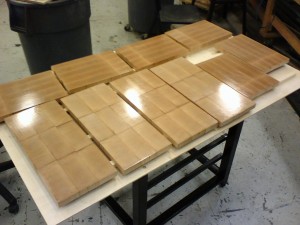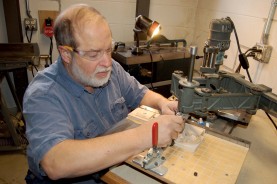Type High means Type High
One of the major frustrations early in my cutting wood type led to my ability to generate lots of type high, perfectly smooth, end grain maple and the construction of an original MWT machine.
I already owned a small, CNC training end mill machine so old that it would not talk to a modern computer, but could be hand cranked on the X, Y, and Z-axis. Perfect for cutting small ornaments, stars, hearts, state outlines, and one replacement letter at a time. Round letters and curves were “Etch-A-Sketch” feeding but I became very good at it. The problem was getting end grain maple at exactly type high at a reasonable cost.
Internet searches and many phone calls later I found a company that sold engraving supplies for artist and schools that sold “Type High” engraving blocks of end grain maple. I ordered several 4″ x 5″ blocks at a very steep cost. They were beautiful and smooth. However, when I started cutting type, we quickly found at make-ready time that they were NOT type high. A quick check with a micrometer proved that one block was .020″ under size and the second was .024″ under. A phone call to the supplier resulted in the explanation that the wood blocks started ay .918″ but the sanding process was very time consuming for him and that “no one really cared that they were under size. Just pad up the back before you print your engravings.”
I explained that I could not expect customers to do that to any type I sold. Type high means type high. New wood type should not have to be padded, or the rest of the printing surface brought up to the level of a piece that is manufactured too high. I have been teaching Industrial Arts for 35 years, so the process of preparing sugar maple to a beautiful smooth finish is nothing new to me. Getting end grain maple to exactly .918″ was only a challenge to be resolved.
Nick Sherman’s photos from his trip the Hamilton Wood Type Museum that were posted on Flicker showed me that their multiple surfacing sanding machine was part of the solution. Two months of planning and design work and an addition two months of construction resulted in the Moore Wood Type Machine, Serial Number 001. A 300-pound tall cube of welded and machined steel and aluminum that I am proud to say works very well. After a few experimental tries, and purchasing several larger motors, my new type-high machine lets me bring a block of end grain sugar maple to exactly .918 inch, plus or minus .002″ with a glass smooth finish.
Thanks to conversations with Jim Moran, Dave Churchman, and several professional engravers, I also apply the historical three coats of spray bull’s Eye Shellac, rubbed out with XXX fine pumice powder and “Boiled Linseed Oil,” just like in several historical reference pictures I found. You should never use “Raw” linseed oil. From my days as the carpenter and blacksmith at 1880 Slate Run Historical Farm near Columbus, I knew that raw linseed oil will take many days to soak into the wood and leaves the surface slightly tacky.




